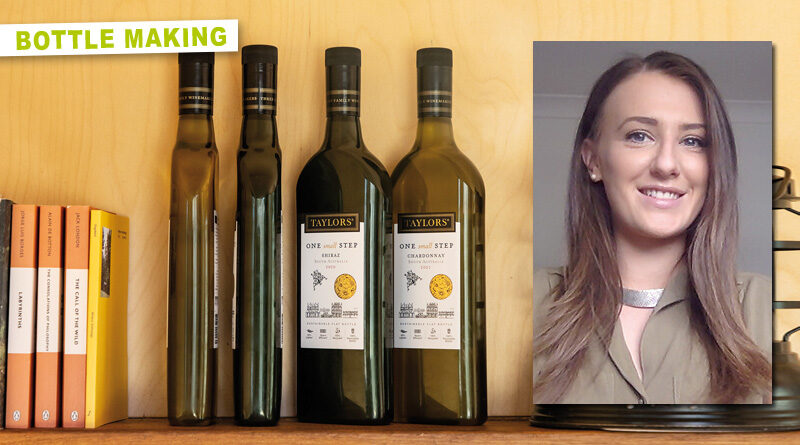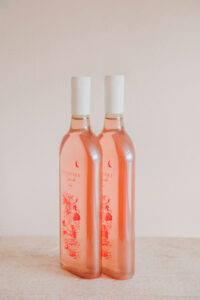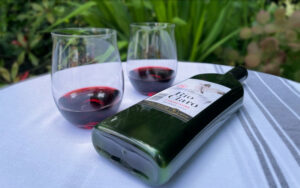Bottles for the 21st century
Interview with Amelia Dales, Commercial Director, Packamama
The original impetus behind Garçon Wines was the company’s focus on e-commerce friendly wine bottles. The result was the compact bottle shape, which is flat enough to be put through a letter box, and its PET format, which is light and robust enough for easy despatch. Behind the packaging concept and its manufacture is Packamama, the brand’s spin-off. PETplanet spoke to Amelia Dales, Commercial Director, about wine in PET, customer feedback and the focus on sustainability.
PETplanet: At the beginning of the year, Packamama was created as a spin-off from Garçon Wines. What is behind the brand, which parts of the business are yours and which are Garçon Wines?
Amelia Dales: Packamama had been in the works since the end of 2019, but with the onset of Covid-19, we decided to hold spinning off this business line under a new brand. The timing became right at the start of 2022 with the pandemic largely behind us and soon-to-launch collaborations on the horizon. Packamama encompasses the packaging elements of Garçon Wines, supplying dry goods and processing to pioneering wine companies, that is, our IP-protected eco-flat bottles, bottling and secondary packaging. As the business increasingly became focused on business-to-business packaging and collaborating with wine companies, it made little sense to continue with a legacy name that included ‘wines’ in the title. Garçon Wines will continue to operate separately and establish itself instead as a direct-to-consumer sustainable wine brand owner of brands that use eco-flat bottles and other more sustainable packaging formats in the future.
The name Packamama was inspired by the earth goddess Pachamama, with a playful change in letter as we offer Packaging Protecting Mother Earth. This name far better aligns with our vision for a lower carbon future in drinks. Additionally, the name is liquid agnostic, which is important to us as Packamama will provide packaging for more than just wine in the future.
PETplanet: What was the original impetus to package wine in recycled PET?
Amelia Dales: The original impetus came from wanting to make a greater success of wine ecommerce, which in our view was hampered by an inefficient primary pack that was still in use from the 19th century. If you asked a group of intelligence people today to create an optimum packaging format for wine, a product that travels vast distances across the globe through complex supply chains, they would not have come up with a round, glass bottle. It’s a logistics nightmare due to being spatially inefficient, heavy and very fragile. Challenging the base assumptions that wine bottles need to be round and made from glass led to the creation of a bottle that is a flat, cross-section design of the shape consumers knows and love, and made from recycled PET (rPET) to save weight and energy. The functional benefits of PET include being lightweight and shatterproof, while still retaining glass-like qualities such as shine and transparency. PET is also the most widely recycled plastic on the planet, with capacity to make high quality products from its recyclate. Using 100% rPET from the outset was non-negotiable from an environmental perspective because of the importance of putting pre-existing material back to good use, limiting creation of new plastic and contributing to circular economies.
Most importantly, as we more frequently see and feel the alarming impacts of the climate crisis, rPET is a more climate-friendly material to be using for wine, an industry whose carbon footprint hotspot comes from the glass bottle. rPET saves energy and weight in production, transport and recycling compared to both glass and virgin PET to slash carbon emissions and so is the best-in-class material for wines that don’t require bottle aging.
PETplanet: Are there plans to expand into other beverage segments such as sparkling wine or beer?
Amelia Dales: We’re starting in wine because packaging represents a carbon footprint hotspot and the single greatest impact producers can make in reducing their carbon emissions is to change the bottle. We also specifically designed our bottles to pay homage to the tradition and beauty of the world of wine through the cross-section Bordeaux design, retaining the emotional connection and recognition of wine from a bottle. However, we do plan to expand into other beverage segments, such as spirits and bottled water and other liquid foodstuffs such as vinegar and olive oil. We would like to be able to find a solution to package sparkling wines and other carbonated beverages like beer, but the pressure exerted on the flat panels means that, for now, the bottles are only suitable for still liquids.
PETplanet: The wine-buying public has a reputation for being rather traditionally-minded when it comes to purchasing and is often sceptical about wine in plastic bottles. How do you manage to convince wine producers to bottle in PET?
Amelia Dales: The wine industry is steeped in a rich heritage and is generally slower to adopt innovation. But there are plenty of instances where it has adapted and continues to do so, whether that is adopting screw caps to changing perceptions about packaging wines in bag-in-box or cans.
As our bottle is inspired by the traditional shapes that producers and consumers know and love, we call it an advancement to traditional bottles. It is a better bottle for the 21st century, rather than an alternative format. The main areas we highlight to producers are that our bottles will protect both their wines and our planet. We demonstrate that our packaging protects their wines through the 19-21 months shelf-life, and using PET that’s certified food-grade to FSA and Efsa standards and is a stable, inert material. For protecting the planet, the evidence is clear that we need to be reducing carbon emissions, and the evidence is also clear that in wine, recycled PET is the better option for a lower carbon, monolayer bottle which is available to scale now. Innovation is fundamental to help wine producers futureproof themselves through continuing to appeal to generations that are highly eco-conscious. These generations will have to live with the planet that we’ve damaged so badly and will not accept products with an unnecessary carbon footprint, especially if a better option is available.
Previously, the bar for PET wine packaging has been set too low, using virgin material, aluminium caps that can have a negative impact on recyclability and having a bottle that looks smaller standing next to its 750 ml glass counterpart. Through shape innovation, best-in-class material and recyclability by design, we’ve changed the rhetoric. Both consumers and business customers are intrigued and interested to know more about why we do what we do, providing a platform to communicate why this packaging change is positive and needed.
So far, we’ve brought on board Accolade Wines (the UK’s number 1 wine company), Château Galoupet (a Provence estate owned by luxury goods giant LVMH), Miguel Torres Chile (climate action champions in wine) and Taylors Wines (one of Australia’s first families of wine). More will follow. We engage with the larger producers as it is the largest and most respected producers that can make the greatest impact. Small/er producers are more likely to use our eco-flat bottles once they see the largest progressing.
PETplanet: Do you have a few examples of consumers‘ feedback on the PET bottles?
Amelia Dales: As Packamama is not a wine brand owner, we do not directly interact with consumers. However, from what we’ve seen on social media, there is a 70% positive sentiment towards our format and just a 2% negative. We also pay attention to reviews left on retailer sites. On Tesco.com, where Accolade Wines’ brand Banrock Station is available, there is a roughly 80% positive sentiment towards the bottles.
Specific comments from these reviews include “I was convinced this would taste different, due to being in an ‘odd’ bottle. However, this was not the case; full bodied, fruity and really enjoyable to drink. The fact I don’t have to clink up the glass bottle bank at the top of the road is a plus, as could go directly into my own household recycling. Big thumbs up from me, and will buy more, the bottle shape also takes up less space for storage which is another bonus” and “Love the packaging too, light and compact and just the thing to take on a summer picnic, sustainability is an added bonus.”
Any comments indicating repeat purchase intention is a clear sign of good consumer uptake and acceptance, so we are particularly pleased to see this.
PETplanet: In which (geographical) markets are you active, which could follow soon?
Amelia Dales: Packamama is active with production capabilities in the UK and Australia. The brands that use our bottles distribute them beyond just these countries though, so wines in eco-flat bottles are available in the Nordics and Canada too, and online via certain European e-retailers.
Our top priority for international expansion is to establish a team and production capabilities in the USA. This is an attractive market as it is the top wine consuming country and the fourth largest wine producing country in the world.
PETplanet: Oxygen ingress is more of an issue for beverages in PET than in glass. How have you solved it so that the quality of the wine does not suffer?
Amelia Dales: Our bottles use an advanced barrier technology that’s introduced prior to the bottle blowing process to ensure that the format is still monolayer, which is important from a recyclability perspective. This barrier features an active oxygen scavenger and passive carbon dioxide barrier, giving the wines in our bottles a shelf-life of 19-21 months according to real-time and modelled shelf-life analysis. This is more than enough time for most wines given that around 85% of wines produced are for everyday drinking and are consumed shortly after purchase.
PETplanet: The glass industry is particularly affected by rising energy prices. Have there already been cost-driven conversions from glass to PET bottles among your new customers?
Amelia Dales: You’re correct that recycled PET requires less energy than glass, as it can be produced and recycled at much lower temperatures. This also cuts costs in the supply chain. That said, 100% recycled PET is still facing the good problem of demand increase, and some price increase as a result. Resource scarcity of this nature, whether it be glass or recycled PET, goes to show the importance of keeping valuable resources in circulation and accelerating the transition to a circular economy to slash carbon footprint. We tend to find that our customers’ primary motivations for using eco-flat bottles are related to sustainability targets, staying relevant amongst their consumers bases and appealing to new shoppers, rather than cost-cutting at the moment. However, we have certainly seen an increase in enquiries related to the rising cost of glass along as well as availability and lead times, with larger industries such as beer and spirits taking priority.
PETplanet: Thank you very much for these interesting insights into your business!




